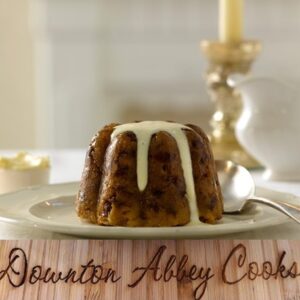Plum pudding has been served in Britain on special occasions for hundreds of years, most notably at Christmas. Families gather on Stir Up Sunday to make their puddings, the last Sunday before Advent. A flaming version took center stage at Christmas dinner at Downton.
Plum pudding also appeared on the 2nd and steerage class passenger menus on the ill-fated voyage of the Titanic.This recipe comes from Last Dinner on the Titanic.
Traditional Plum Pudding
Plum pudding has been served in Britain on special occasions for hundreds of years. A flaming version took center stage at Christmas dinner at Downton. Families gather on Stir up Sunday to make their puddings; the last Sunday before Advent.
Equipment
Ingredients
- 1 cup chopped suet*
- 1 1/2 cups slivered blanched almonds
- 1 1/2 cups raisins
- 1 1/2 cups currants
- 1 1/2 cups candied peel
- 1/4 cup prunes pitted and chopped
- 1/2 cup rum or orange juice
- 1 1/2 cups all-purpose flour
- 1 cup bread crumbs
- 1 tsp. cinnamon
- 1 tsp. nutmeg
- 1/2 tsp. allspice
- 1/2 cup butter softened
- 2/3 cup sugar
- 5 large eggs beaten
- 1/2 cup milk
- 1/3 cup rum or orange juice
Instructions
- In a large bowl stir together suet, almonds, marinated fruit, flour, bread crumbs, cinnamon, nutmeg, and allspice.
- In another bowl beat together the butter and sugar. Add eggs, one at a time, beating well after each addition. Stir in milk and rum. Using a large spoon stir (traditionally from East to West) half of the fruit mixture into the egg mixture until well combined. Stir in the remaining fruit mixture.
- If you have the time you can let sit overnight for the flavours to blend.
- Grease and flour a six-cup pudding basin or metal bowl. Spoon the mixture into your pudding basin and pack tightly to the top. Add a lid or fashion one with tin foil.
- Place basin in rack of steamer or rack in large pot and pour in enough boiling water to come two-thirds of the way up the sides of the mould. Cover and simmer on low heat, adding more boiling water as necessary, for 2 1/2 – 3 hours or until tester inserted in center comes out clean.
- At this point, let cool, then wrap in tinfoil and store until Christmas.
- Unmold pudding onto a serving dish.
- Heat 1/4 cup of rum, carefully use match to set on fire and then pour over the pudding and display.
- Slice and serve with sweet sauce.
Notes
*Suet is the hard fat which comes from around the kidneys of cows and sheep. If you want to be true to the recipe, find a butcher which would be the most reliable source for suet as you might end up with suet used in bird feeders. Suet has a high melting point, so it serves as a place-holder in puddings and crusts when the dough has begun to set, and long after other fats would have melted. As a result, the structure of the pudding is already defined by the time the suet melts, leaving thousands of tiny air holes that give the pudding a light and smooth texture. If you do wish to use a substitute, go with solid vegetable shortening, but it won’t be the same.
Pudding Traditions
- Christmas pudding traditionally contained 13 ingredients to represent Jesus and his disciples.
- Each family member from East to West traditionally stirs it (while making a wish) to remember the Wise Men who visited Jesus in the Nativity Story.
- The customary garnish of holly represents the crown of thorns, but the holly berries are toxic, so you may wish to pass on that tradition.
- Adding coins, originally charms, to the pudding was said to bring luck if you found them in your portion on Christmas Day. The traditional lucky charms were a silver coin for wealth, a wishbone for luck, a thimble for thrift, a ring for marriage, and an anchor for safe harbour. This tradition is much like Barmbrack served at Halloween.
Tried this recipe?Let us know how it was!


